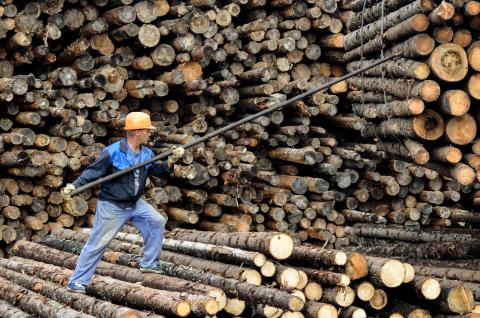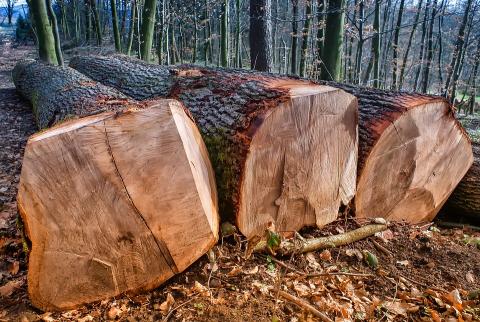China: Reduced risk of illegal timber in supply chains as revised forest law kicks in
A new update of the Sourcing Hub’s Risk Assessment for timber legality in China is currently in public consultation. The report shows several improvements in relation to risks of legal non-compliance for some areas of forest management law, while a few other risks - both at the forest level and in the supply chain – remain. Risks in relation to imported illegal timber being mixed into production and trade are highlighted.
Sourcing timber harvested from mainland China now involves slightly fewer legal risks, according to a new risk assessment on China published on the Sourcing Hub.
A tool for legality and risk mitigation, Preferred by Nature’s Sourcing Hub is regularly producing legality risk assessments on major timber exporting countries, which are used by import businesses undertaking Due Diligence on their supply chains.
In a new update of its risk assessment for China (mainland only), the general risk score has dropped from 73 to 79 points on an index with a score of 100 being the lowest risk possible.
There has been some improvement, according to Gaojun Zhao, Senior Responsible Sourcing Specialist:
“There have been positive changes in recent years within China, helping to reduce risks in relation to forest management. For example, the quantity of timber harvested without a harvest permit is extremely low. Authorities have also intensified controls through improving the enforcement system and the application of new technologies, and penalties are generally very severe. Together with economic growth, these changes are making it less attractive to operate outside the official market and reduces the risks related to illegal harvesting for businesses looking to import wood originating from China,” said Gaojun Zhao.
Read the full risk assessment here
Some risk challenges remain
Despite an improved risk score, mitigation measures in relation to harvesting rights and some harvesting activities may still be required. Also, some non-compliance risks issues remain in production and trade, which should still be observed within buyers’ due diligence systems (DDS) according to Gaojun Zhao.
However, for some of the identified areas of risks, less effort may now be needed to address them. For example, to mitigate the risks related to value-added tax (VAT) in the supply chain, the buyer conducting due diligence can request and check VAT invoices against an online official government database which will provide an indication of VAT payment. VAT invoice is also a key document to map the supply chain.
Other risks continue to be a challenge to address, including risks that legal timber may be mixed in supply chains with wood materials of unknown or illegal origin, as well as risks related to timber harvesting activities. Support from local expertise and resources would be necessary to obtain sufficient information and deploy effective mitigation actions, such as supply chain verification.
“It is worth noting that in our assessment, the risk of legal non-compliance in relation to harvesting permits has been downgraded on a general level. Although, obtaining a harvest permit is still valuable for a downstream buyer to confirm land tenure, origin and species declared by Chinese companies, as well to evaluate the risk of ‘mixing’ in supply chains ,” said Gaojun Zhao.
Risks of mixing with timber of unknown or illegal origin
It is well known China is a big trade hub of global timber products. The value of timber products that China imports and exports, accounts for around 12% of global value in 2018. In 2018, 96 million cubic meters of logs and sawn timber originating from other countries were imported into China. That compares to 84 million cubic meters timber harvested in China in the same year.
China is one of the world’s largest importers of illegal timber, with up to 80 percent of tropical imports coming from countries with weak governance, according to Global Witness.
While our risk assessment shows the legal risks for domestically harvested timber in China has been reducing over time, the risks of imported timber from higher-risk countries (e.g., tropical species) entering into wood supply chains remains an ongoing concern. These risks must be evaluated and addressed.
China’s recently revised forest law has been cautiously applauded by green NGO’s, hoping it will help stem the flow of illegal timber passing via China to world markets. However, whether the revision of the law will make any significant impact on the traffic of illegal timber entering China remains to be seen. There is still a relatively high risk of illegal timber entering their supply chains, according to David Hadley, Senior manager of Tailored Services at Preferred by Nature.
“China is characterized by a market with many small-medium suppliers, and supply chains are often very complex. This can make it a challenge to identify any non-certified or illegal timber that may have been mixed into wood products during processing. With the revised law, transport permits are no longer required. While this has reduced the legal risk from a due diligence perspective, as legal documentation is no longer required, it may be harder to trace wood origins and evaluate mixing risks in timber supply chains. As a result, it is very important that overseas buyers have confidence, and are able to justify if and how the risk of mixing has been mitigated. Addressing the risk of mixing in a robust way is challenging and, as a result, local resources/expertise can be helpful,” said David Hadley.
Forest certification/verification schemes remain a powerful risk mitigation option within any due diligence system, to address risks within timber harvesting activities, as well as the challenging issues in China concerning “risk of mixing”, though there is no “green lane” for certification/verification under mainstream timber legislations (e.g., EUTR). In China certification/verification schemes (e.g., FSC, PEFC) have been growing rapidly in the past decade. By the end of 2020, 25% (11,740) of all certificates issued by FSC are located in China, including 85 certificates for forest management covering 1.2 million ha forest. More recently, concerns have been raised by some stakeholders about risks to the integrity of certified supply chains, as false certification declarations by some companies is identified as an ongoing challenge. Buyers need to have confidence that the products are really made of certified timber. They can do this by requesting additional information on the certified supply chains behind the certified products they are sourcing.
The Risk Assessment for China is currently under consultation and all stakeholders interested in timber legality issues in China are invited to contribute here . The public consultation will end on 26 March and the finally approved risk assessment will be made available in the beginning of April.
It was based on an assessment methodology jointly developed by Forest Stewardship Council (FSC) and Preferred by Nature and provides an analysis of the risk of sourcing timber from areas of illegal harvesting, trade and transport in China. The first assessment was partly funded by the UK aid from the UK government and the European Commission. The publication does not constitute endorsement of the contents which reflect the views only of the authors, and the UK aid and Commission cannot be held responsible for any use which may be made of the information contained therein.
The key legality risks identified concern timber harvested in China and cover legal rights to harvest, taxes and fees, timber harvesting activities and trade and transport.
In the updated Risk Assessment, Preferred by Nature has expanded the scope to cover Traceability and risks related to imported material. However, the risk score for China has been calculated only on risks related to the legality of domestically harvested timber. Specified Risk for five sub-categories, Low Risk for 9 sub-categories and No legal requirements for 7 sub-categories for wood harvested in China was identified. The risk score is based on a reverse Index, in this case 79 of 100 points.
Risks identified in report indicator 1.22 was not included in the risk score calculation, and neither was the risk related to import or supply chain risks.
Learn more about the Sourcing Hub’s rating system here.




